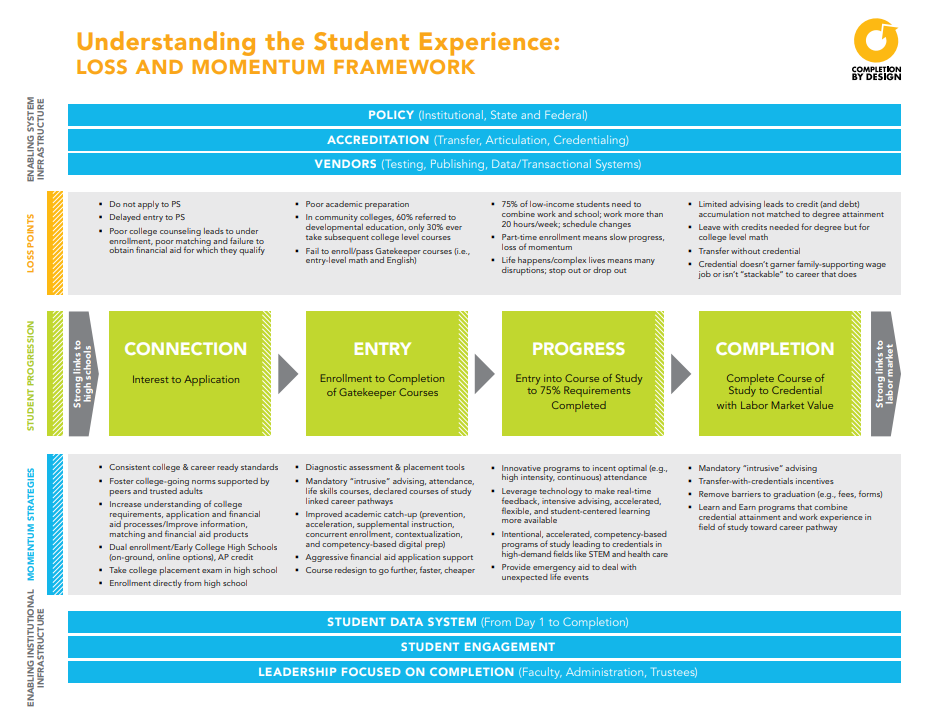Understanding the Student Experience: Loss and Momentum Framework (LMF)
Publication Date: 2014
Format: Framework/Infographic

This visual resource explains the Loss and Momentum Framework (LMF), a conceptual tool for understanding how students move through four key phases of progression: Connection, Entry, Progress, and Completion. It illustrates five interconnected layers, including Loss Points, Momentum Strategies, Enabling System Infrastructure, and Enabling Institutional Infrastructure, that help identify where students encounter barriers or build momentum. With concise examples throughout, the framework supports colleges in mapping the student experience, identifying points of intervention, and designing strategies that address both academic and non-academic factors influencing success.
Connections to the Transformation Journey
and How Institutions Transform
Stages of Transformation
- Start the Process: This resource offers a concise, intuitive way to introduce the concept of the student experience, especially valuable in early transformation efforts. It helps leadership teams explore how to organize their efforts and gives campus stakeholders a common structure and language for sequencing and aligning strategies.
- Sharpen the Focus: The framework provides concrete structure for reflection and analysis through the four phases of Student Progression—Connection, Entry, Progress, and Completion. It helps institutions identify opportunities for improvement by mapping policies, practices, and momentum strategies to each phase of the student journey.
Learn more about the Transformation Journey and How Institutions Transform.
Evidence-Based Practices
- Other Holistic Supports: This resource introduces momentum strategies that overlap with several evidence-based practices highlighted across the site. These include:
- Advising: e.g., mandatory “intrusive” advising
- Developmental Education: e.g., improved academic catch-up supports
- Digital Learning: e.g., technology-enabled, flexible, student-centered models
The framework helps clarify how these strategies support student success across different stages of progression.
Learn more about the Transformation Journey and How Institutions Transform.
Continuous Improvement
This resource is most relevant to the following cross-functional roles:
- Senior Leaders: This resource can help senior leaders visualize and communicate the student experience and understand where institutional strategies intersect with key phases. It also surfaces enabling infrastructure that leaders can prioritize to support lasting change.
- Mid-Level Leaders: Mid-level leaders can use this framework to make connections between reforms and phases of student progression. It also supports team organization—whether by student journey phase or by momentum strategy.
This resource connects to the following phase(s) of the PRPAM framework:
- Prepare: This resource is most relevant to the Prepare phase, when institutions are just beginning to explore transformation. It introduces the student experience in clear, visual terms and surfaces when and how key practices, policies, and strategies contribute to student success.
Learn more about the Transformation Journey and How Institutions Transform.
Other Considerations
- This document presents the original Preventing Loss, Building Momentum Framework (commonly called the Loss/Momentum Framework or LMF), developed during the Completion by Design initiative. It was later updated by Achieving the Dream – see Loss-Momentum Framework: Revised
Learn more about the Transformation Journey and How Institutions Transform.
Stages of Transformation
- Start the Process: This resource offers a concise, intuitive way to introduce the concept of the student experience, especially valuable in early transformation efforts. It helps leadership teams explore how to organize their efforts and gives campus stakeholders a common structure and language for sequencing and aligning strategies.
- Sharpen the Focus: The framework provides concrete structure for reflection and analysis through the four phases of Student Progression—Connection, Entry, Progress, and Completion. It helps institutions identify opportunities for improvement by mapping policies, practices, and momentum strategies to each phase of the student journey.
Learn more about the Transformation Journey and How Institutions Transform.
Evidence-Based Practices
- Other Holistic Supports: This resource introduces momentum strategies that overlap with several evidence-based practices highlighted across the site. These include:
- Advising: e.g., mandatory “intrusive” advising
- Developmental Education: e.g., improved academic catch-up supports
- Digital Learning: e.g., technology-enabled, flexible, student-centered models
The framework helps clarify how these strategies support student success across different stages of progression.
Learn more about the Transformation Journey and How Institutions Transform.
Continuous Improvement
This resource is most relevant to the following cross-functional roles:
- Senior Leaders: This resource can help senior leaders visualize and communicate the student experience and understand where institutional strategies intersect with key phases. It also surfaces enabling infrastructure that leaders can prioritize to support lasting change.
- Mid-Level Leaders: Mid-level leaders can use this framework to make connections between reforms and phases of student progression. It also supports team organization—whether by student journey phase or by momentum strategy.
This resource connects to the following phase(s) of the PRPAM framework:
- Prepare: This resource is most relevant to the Prepare phase, when institutions are just beginning to explore transformation. It introduces the student experience in clear, visual terms and surfaces when and how key practices, policies, and strategies contribute to student success.
Learn more about the Transformation Journey and How Institutions Transform.
Other
Considerations
- This document presents the original Preventing Loss, Building Momentum Framework (commonly called the Loss/Momentum Framework or LMF), developed during the Completion by Design initiative. It was later updated by Achieving the Dream – see Loss-Momentum Framework: Revised
Learn more about the Transformation Journey and How Institutions Transform.
Recommended Citation: Completion By Design. (2014). Understanding the Student Experience: Loss and Momentum Framework.

